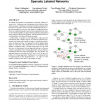131
click to vote
ICCV
2007
IEEE
15 years 6 months ago
2007
IEEE
This paper treats tracking as a foreground/background classification problem and proposes an online semisupervised learning framework. Initialized with a small number of labeled ...
86
Voted
ICDM
2008
IEEE
15 years 6 months ago
2008
IEEE
In this paper, we present a novel feature extraction framework, called learning by propagability. The whole learning process is driven by the philosophy that the data labels and o...
112
click to vote
SIGIR
2009
ACM
15 years 6 months ago
2009
ACM
When search is against structured documents, it is beneficial to extract information from user queries in a format that is consistent with the backend data structure. As one step...
110
Voted
PKDD
2009
Springer
15 years 7 months ago
2009
Springer
Most existing semi-supervised learning methods are based on the smoothness assumption that data points in the same high density region should have the same label. This assumption, ...
115
click to vote
ICB
2009
Springer
15 years 7 months ago
2009
Springer
Biometric authentication using mobile devices is becoming a convenient and important means to secure access to remote services such as telebanking and electronic transactions. Such...
98
Voted
ICDAR
2009
IEEE
15 years 7 months ago
2009
IEEE
Training a system to recognize handwritten words is a task that requires a large amount of data with their correct transcription. However, the creation of such a training set, inc...
PAKDD
2009
ACM
15 years 7 months ago
2009
ACM
In this paper we propose to study budget semi-supervised learning, i.e., semi-supervised learning with a resource budget, such as a limited memory insufficient to accommodate and/...
101
click to vote
WWW
2010
ACM
15 years 7 months ago
2010
ACM
In this paper, we propose a semi-supervised learning approach for classifying program (bot) generated web search traffic from that of genuine human users. The work is motivated by...
59
Voted
WSDM
2010
ACM
15 years 9 months ago
2010
ACM
115
click to vote
KDD
2008
ACM
16 years 24 days ago
2008
ACM
We address the problem of classification in partially labeled networks (a.k.a. within-network classification) where observed class labels are sparse. Techniques for statistical re...




